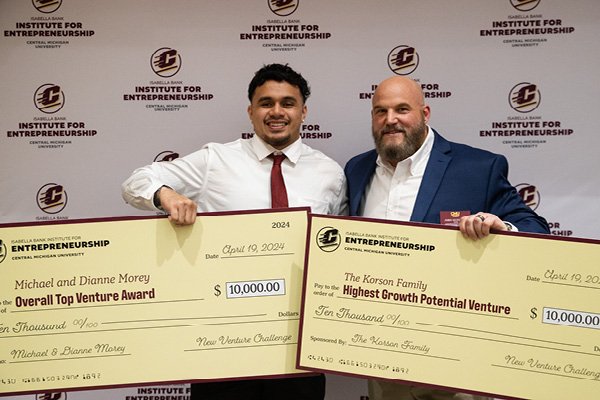
Start up

Passion. Potential. Pitches. Don't miss any of the 2025 New Venture Challenge excitement.
Tune in Friday, April 11 at 1 p.m. for great ideas and fierce competition. Then, join the judges, mentors, spectators and teams as they see who is going home with thousands of dollars in venture financing. The awards broadcast begins at 6:30 p.m. and one team will walk away as the overall best venture.
Central Michigan University’s College of Business Administration is the home of the Isabella Bank Institute for Entrepreneurship and the first Department of Entrepreneurship in the state of Michigan. We are a student-centric hub where experiential, curricular, and external entrepreneurial opportunities intersect.
Our mission is to maximize student success by fostering a campus-wide entrepreneurial mindset that promotes inter-disciplinary collaboration and the creation of new ventures.
We aim to create innovative programming, boost cross-campus and ecosystem collaboration and provide a comprehensive mentoring program.
Our institute provides extracurricular opportunities and is open to all undergraduate and graduate CMU students.
Are you interested in becoming an entrepreneur?
Every journey is unique. Explore the opportunities that interest you.
Amanda Borchardt, a graduate student studying Applied Experimental Psychology with Emily Bloesch Ph.D., researched hand proximity effect and the distance of stimuli from the hand. Hand space is an imaginary boundary that represents the spatial extent of intentional hand movements within an environment. Hand proximity effect suggests that the placement and position of one’s hand within an environment can affect a variety of cognitive processes like attention and memory. Typically, hand proximity effect is measured while the hand is positioned near or far from an object or stimuli.
In Borchardt’s thesis, she focused on an intermediate distance while measuring event-related potential changes and reaction time. Her thesis supported previous findings that a hand positioned close to an object creates a stronger attentional response compared to when the hand is farther away.
Previous research showed that the greatest decline in attention occurred between the near to far distance. In contrast, Borchardt’s research found that the greatest decline in attention occurred as the hand distance increased from the near to the intermediate distance, with a lesser decline in attention as the hand distance increased from the intermediate to far distance. Borchardt says, “the existing literature might be comparing stimuli near the hand versus those positioned at the boundary of hand space instead of within and outside the boundary of hand space.”
Borchardt set out to close the gap in existing literature, with little research focusing on measuring the boundary of hand space. Borchardt says, “I hope the results of my master’s thesis inspire more studies to test near-, intermediate-, and far- hand trichotomies instead of previously noted near- and far-hand dichotomies.”
This story is brought to you by the Office of Research and Graduate Studies.